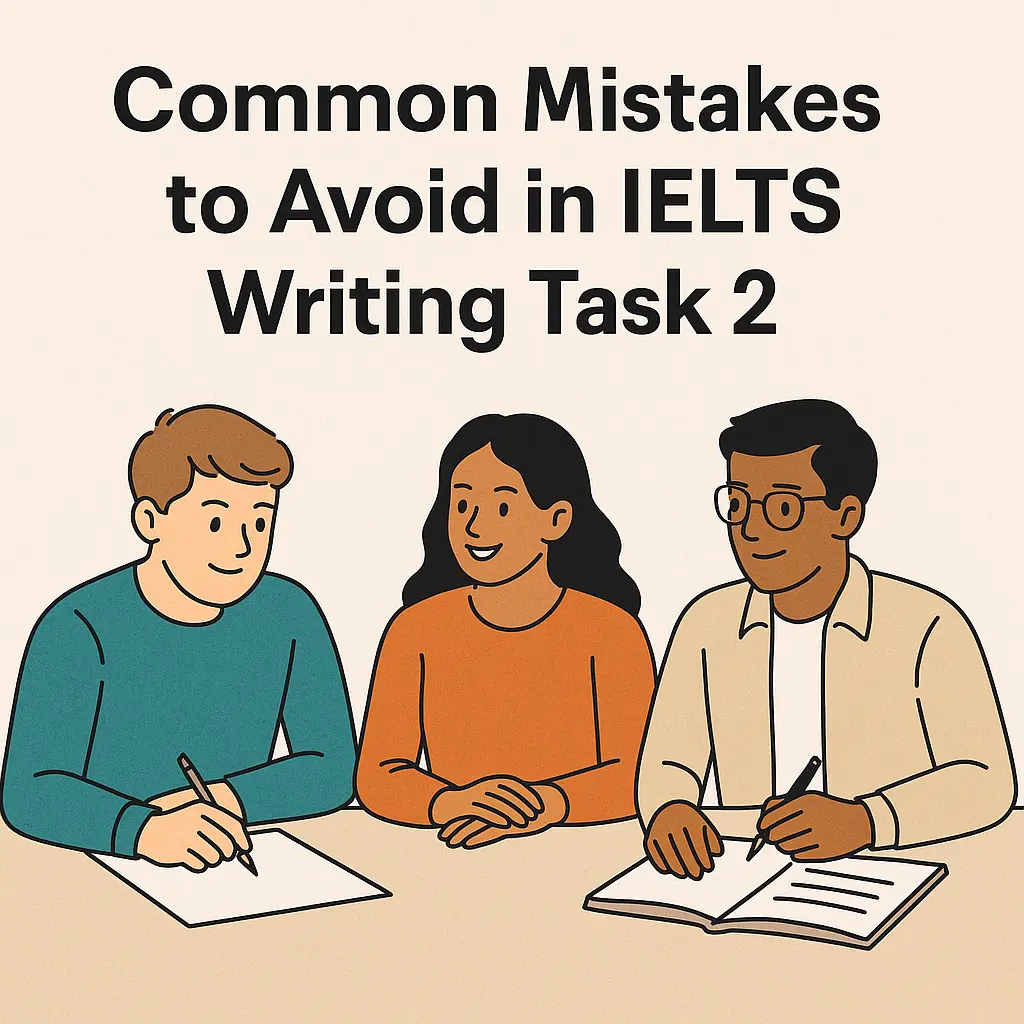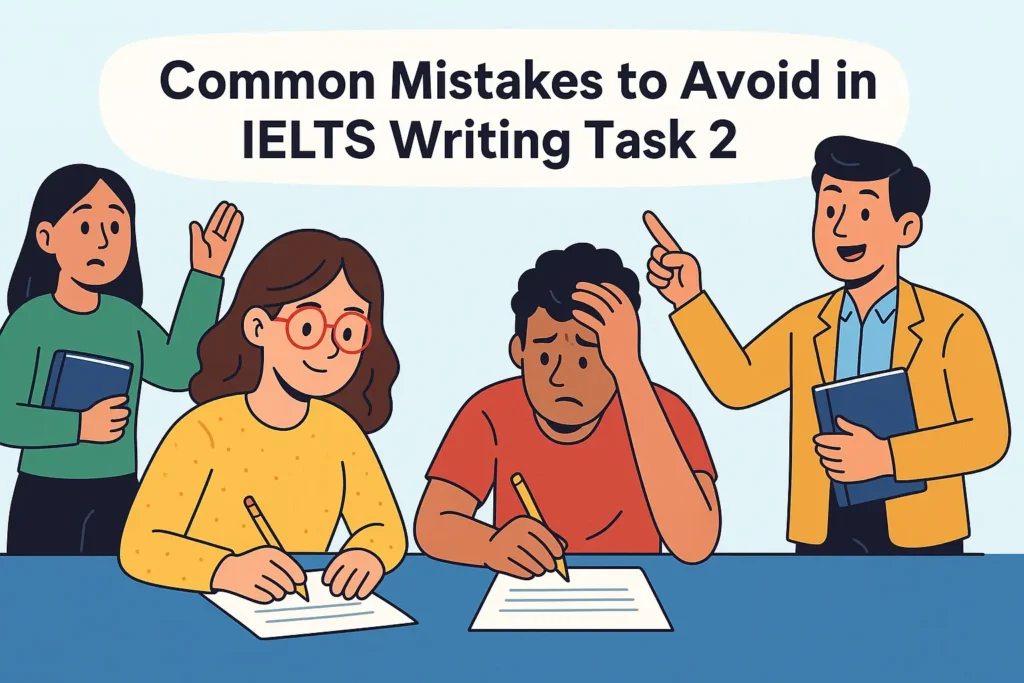The IELTS Writing Task 2 is often considered the trickiest part of the exam. Why? Because it demands more than just good English — it tests your ability to present a logical argument, support it with evidence, and follow a structured format.
If you’re aiming for Band 7 or above, you must not only write well, but also avoid common mistakes that could cost you marks. In this guide, we’ll break down the top errors students make in IELTS Writing Task 2 — and how you can avoid them with confidence.
🧠 Overview of IELTS Writing Task 2

- Type: Formal essay
- Time: 40 minutes
- Word count: At least 250 words
- Question types: Opinion, Discussion, Problem-Solution, Advantage-Disadvantage, Double Questions
Also Read
Step-by-Step Guide to Applying for a UK Student Visa
🚫 10 Common Mistakes to Avoid in IELTS Writing Task 2
1. ❌ Not Answering the Question Properly
Mistake: Writing off-topic essays or misunderstanding the task.
Solution:
- Read the question twice and underline keywords.
- Identify the type of essay being asked (opinion, discussion, etc.).
- Plan your essay before writing.
2. ❌ Poor Essay Structure
Mistake: Writing in a block of text or using no clear paragraphing.
Solution: Use the standard IELTS essay structure:
- Introduction
- Body Paragraph 1
- Body Paragraph 2
- Conclusion
Use topic sentences and connectors to guide the reader.
3. ❌ Weak Thesis Statement
Mistake: Failing to state your opinion or main idea clearly in the introduction.
Solution:
- Write a concise thesis in the final line of your intro.
- E.g., “This essay will argue that governments should invest more in public transport than in road infrastructure.”
4. ❌ Overusing Complex Vocabulary or Repetition
Mistake: Using “big words” incorrectly or repeating the same words.
Solution:
- Focus on clarity and accuracy.
- Use synonyms and paraphrase smartly.
- Learn collocations and topic-related vocabulary.
5. ❌ Poor Grammar and Tense Usage
Mistake: Frequent grammar errors or incorrect tense usage.
Solution:
- Use simple and compound sentences correctly.
- Stick to present simple or present perfect for general topics.
- Proofread your essay in the final 5 minutes.
6. ❌ Not Supporting Arguments with Examples
Mistake: Making claims without justification.
Solution:
- Use specific examples: “For instance, in Singapore, the government has…”
- Avoid personal anecdotes unless clearly relevant.
7. ❌ Using Informal Language
Mistake: Using conversational phrases like “a lot of,” “kids,” or “gonna.”
Solution:
- Use formal academic language.
- Say “children” instead of “kids,” “many” instead of “a lot of.”
8. ❌ Word Count Issues
Mistake: Writing less than 250 words or too much (e.g., 400+).
Solution:
- Aim for 270–290 words.
- Practice writing under timed conditions.
9. ❌ Not Varying Sentence Structures
Mistake: Writing all short or all long sentences.
Solution:
- Mix it up: Use a blend of simple, compound, and complex sentences.
- E.g., “Although some people prefer public transport, others believe private vehicles offer more freedom.”
10. ❌ Weak Conclusion or No Conclusion
Mistake: Failing to summarize or restate your position.
Solution:
- Restate the thesis in different words.
- Briefly summarize your key points in 2–3 sentences.
Also read
Top 10 Benefits of Studying in the UK vs. US: A Complete Guide for International Students
🔁 Quick IELTS Writing Task 2 Checklist
- Address the question
- Use clear essay structure
- Write 250–290 words
- Include a strong thesis
- Support ideas with examples
- Use varied vocabulary
- Use accurate grammar
- Keep your tone formal
- Proofread for errors
- Add a clear conclusion
Also read
IELTS vs. PTE: Which Test is Better for Studying Abroad?
🤔 FAQs: IELTS Writing Task 2
How is IELTS Writing Task 2 scored?
You’re graded on 4 criteria:
Task Response
Coherence and Cohesion
Lexical Resource (Vocabulary)
Grammatical Range and Accuracy
Each carries 25% of the total score.
Can I use personal pronouns like “I” and “my”?
Yes, especially in opinion essays, but keep your tone formal and avoid sounding too casual.
How long should each paragraph be?
Ideally:
Introduction: 2–3 sentences
Body Paragraphs: 5–7 sentences each
Conclusion: 2–3 sentences
How can I improve my score quickly?
Practice planning essays
Focus on writing under timed conditions
Get feedback from a qualified IELTS tutor
Study high-scoring sample essays
Can I use examples from my country?
Yes, as long as they are relevant, formal, and clearly explained.
📝 Conclusion: Write Smart, Not Just Hard
IELTS Writing Task 2 is more than just good English — it’s about strategy, clarity, and structure. The mistakes mentioned above are extremely common but easy to fix with regular practice and awareness.
By avoiding these errors and following a structured approach, you can significantly boost your chances of achieving Band 7 or higher.
So plan before you write, stick to the structure, and express your ideas clearly — your dream IELTS score is within reach!









